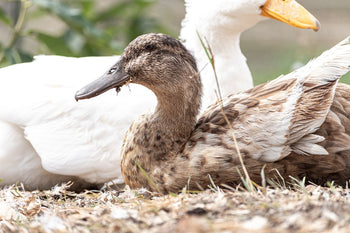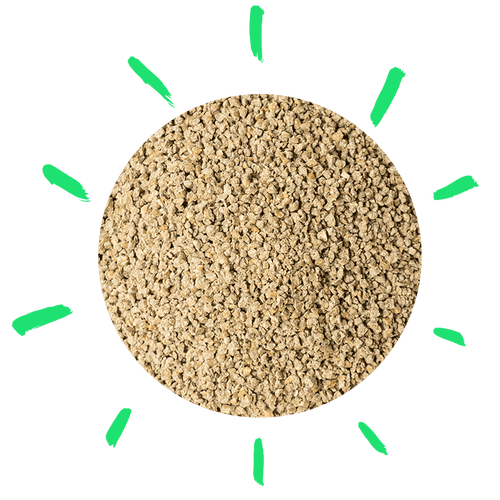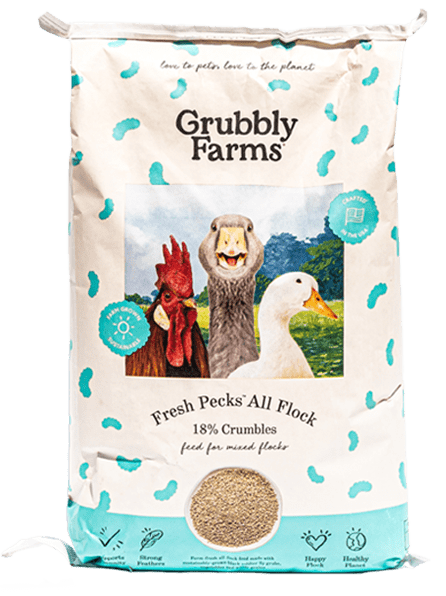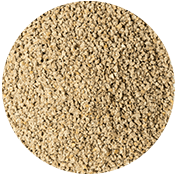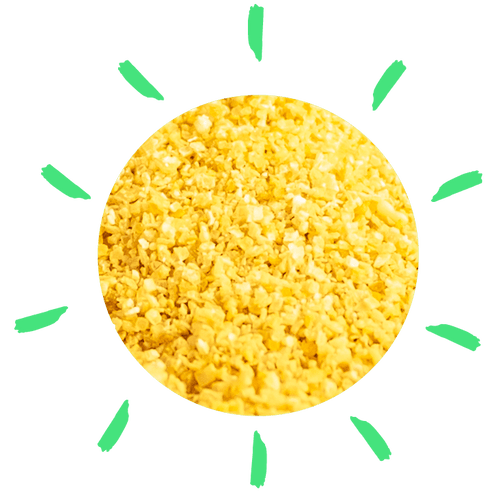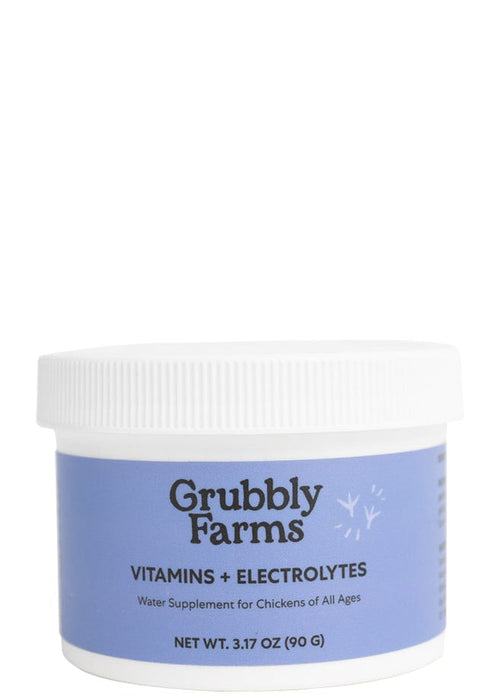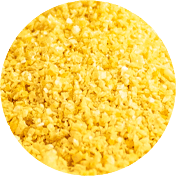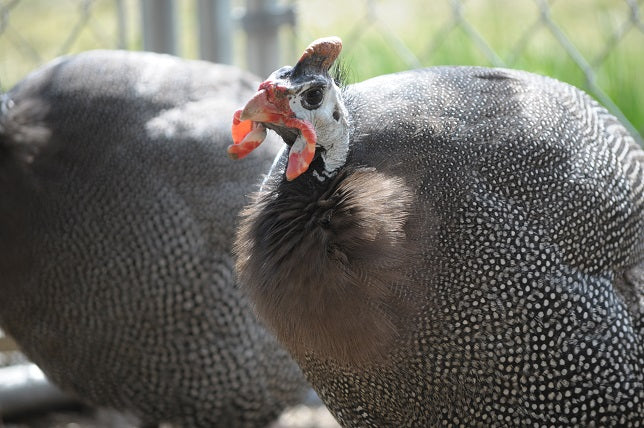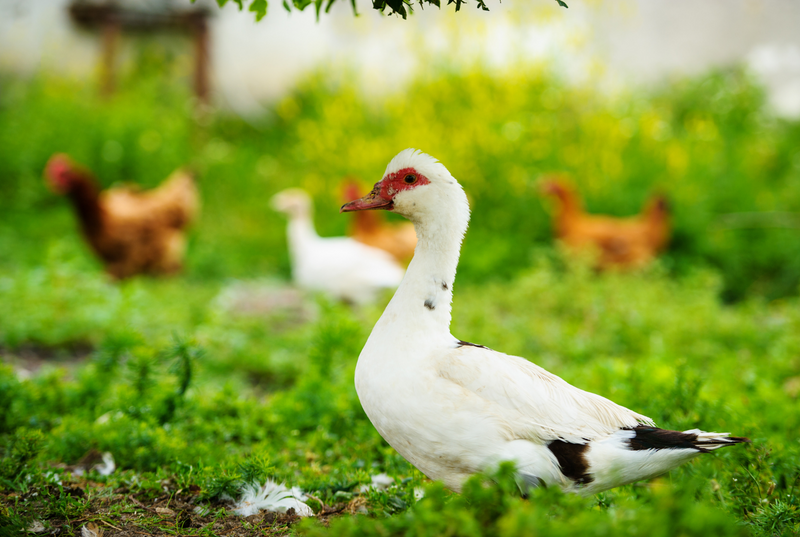In most cases, a mixed flock of poultry refers to a flock that has a combination of different poultry species in it, whether that be chickens, ducks, turkeys, geese, or other poultry. Each one of these species has specific dietary needs, however, raising a mixed flock is possible when you know how to meet the dietary needs of each species in the flock. Knowing how to choose the right feed to ensure the health of all the birds in your flock will help you raise a happy, healthy, and productive mixed flock of poultry!
What Is Considered a Mixed Flock?

A mixed flock is a combination of different species of poultry. A mixed flock can include chickens, ducks, turkeys, geese, pheasants, guinea fowl, and other poultry species. Sometimes a mixed flock can also refer to a flock that has both male and female poultry or a flock that is comprised of different age groups of poultry.
Mixed flocks are common in backyard or homestead settings for several reasons. By raising a mixed flock, you can usually keep all the birds in one coop (as long as the coop is big enough). This prevents you from having to build separate coops for each species. Mixed flocks are also popular for the benefits that different species of poultry can add to the backyard flock. Geese make good guardian animals. Ducks lay large eggs and lay more reliably during the winter. Roosters help with flock protection and allow you to collect fertile eggs for hatching.
A mixed flock that is comprised of different age groups of poultry usually occurs when a broody hen or broody duck is allowed to brood in the coop and stay with the flock even after her eggs hatch. Different age groups of birds may also be present if you integrate young birds into the flock before they are fully matured.
No matter what combination of poultry you have in your mixed flock, you must consider the challenge of meeting the various nutritional needs of each poultry species or age group.
Ducks and Other Poultry in a Mixed Flock

Chickens are usually considered the ‘gateway animal to homesteading’, consequently they are one of the most popular poultry species for folks to start raising in their backyards. If you raise chickens, then you are probably familiar with their dietary needs. But if you add ducks, turkeys, geese, or other poultry into the flock, you will have to deal with the different dietary needs of those species.
Ducks- The dietary needs of ducks differ from chickens in the fact that they require less supplemental calcium than laying hens and they need more niacin in their diet. Ducklings also need a carefully balanced amount of protein in their diet to prevent angle wing.
Turkeys- Since turkeys are a larger species of poultry than most chicken breeds, they need more protein and a higher energy content in their feed. Turkeys are also known to benefit from higher levels of vitamin A & D in their diet than compared to chickens.
Geese- Geese are mostly grazers, which makes their dietary needs different from any of the other poultry species we have discussed so far. They don’t tend to need extra protein or a high energy diet to thrive.
Pheasants- Pheasants have nutritional needs that are the most similar to chickens. However, since pheasants are a gamebird species of poultry, they benefit from higher levels of protein than chickens.
Roosters- Even roosters have different dietary needs than hens. Roosters can thrive on a low energy diet and do not need the higher levels of calcium that laying hens need for producing eggs.
Guinea Fowl- Guinea fowl also have a similar diet to chickens and pheasants. Like the pheasants though, guinea fowl benefit from more protein in their diet than compared to the protein needs of chickens.
Pullets and Adults in a Mixed Flock
Raising a mixed flock of different age groups of poultry also presents its own challenges. Pullets (hens who are under one year of age) have different dietary needs than adult birds. Pullets who haven’t started laying yet don’t need the additional calcium that laying hens need for producing strong eggshells. Since they have no way of using up extra calcium, too much calcium in their diet can lead to kidney issues or even kidney failure.
Additionally, chicks and ducklings who are raised in the flock should not be eating feed that is meant for adult birds. Young ducklings shouldn’t eat a diet that is too high in protein since the extra protein will make them mature at a faster rate than normal, which can lead to improper bone development and a condition known as ‘angle wing’. Young chicks on the other hand, often benefit from a high protein diet at a young age. Neither chicks nor ducklings need extra calcium in their diet like laying hens do.
When raising a mixed flock of different age groups of chickens, it is important to develop a feeding strategy that accounts for birds at different life stages. This can help prevent health issues and ensure proper growth rates for young birds.
What Is Mixed Flock Feed?
A mixed flock feed is a balanced feed formulated for multiple species of poultry. It contains all the essential nutrients needed by various types of birds without excess nutrients that can be harmful to certain species or age groups of poultry.
Mixed flock feed is suitable for chicks, ducklings, and goslings from hatch to maturity. It contains a balanced level of protein and does not contain excess calcium. Additionally, a mixed flock feed will have the proper niacin levels needed by maturing waterfowl species, like ducks and geese. Mixed flock feed caters to pullets who haven’t started laying yet since it doesn’t contain the extra calcium found in layer feed.
Mixed flock feed is also suitable for turkeys and pheasants from eight weeks of age up to maturity. The reason why turkeys and pheasants shouldn’t be started on a mixed flock feed is because they need higher levels of protein for the first eight weeks of their life to mature properly. After eight weeks, they can thrive on a mixed flock feed that has the proper protein and energy levels that they need daily.
Can Chickens Eat All Flock Feed?

Mixed flock feed, or all flock feed, is great for species of poultry like ducks, geese, and turkeys. But it is also safe for chickens to eat too! Chickens can eat all flock feed and still get the nutrition they need to thrive.
All flock feed is slightly higher in protein content than layer feed, which makes it beneficial for heritage and rare breed chickens who benefit from a high protein diet. The biggest concern when feeding all flock feed to chickens is the lack of high calcium levels in the feed.
To accommodate for the lower calcium levels in all flock feed, laying hens should have access to free-choice supplemental calcium. Free-choice supplemental calcium, like crushed oyster shells, allows the hens to consume additional calcium as needed without it being in their feed.
Since all flock feed is higher in protein and lower in calcium than layer feed, it is not only safe for chickens to consume, but it also accommodates the dietary needs of other species of poultry. All flock feed can easily be offered with other free-choice supplements to create a well-rounded diet for various species of poultry, including chickens.
Considerations When Keeping a Mixed Flock

When keeping a mixed flock of poultry, you will need to select a feed that has the correct balance of protein, energy, vitamins, and minerals needed by the different species in the mixed flock. Accommodating the variances in dietary needs of different species of poultry kept in a single flock setup may seem overwhelming. Here are some things to consider when keeping a mixed flock of poultry:
Feed
Laying hens need extra calcium in their diet for laying strong-shelled eggs. Most other species of poultry do not need extra calcium in their diet. Ducks and geese need more niacin in their diet than other species of poultry. Turkeys, pheasants, and guinea fowl need high levels of protein in their diet. Additionally, turkeys benefit from more vitamin A & D in their diet and ducks benefit from a diet lower in protein than other species of poultry.
When choosing a feed, it should accommodate the dietary needs of the species with the lowest nutritional needs. For example, if you are raising chickens and ducks, select a feed for the ducks who need less calcium, then you can offer supplemental calcium for the laying hens who need extra calcium. You can always supplement in the additional nutrients needed by poultry species who have higher nutritional needs.
When raising a mixed flock of different age groups of poultry, select a feed based on the youngest birds in the flock. You can always offer additional supplements to meet the dietary needs of older birds in the flock.
Always feed a non-medicated poultry feed to a mixed flock. Medicated feeds are formulated for chickens and can be harmful to other species of poultry.
Space and Feeding Setup
Along with the type of feed you give your mixed flock, you will also need to consider feeding systems that accommodate various poultry species. Ducks and geese need more water while eating. A duck or goose must have an open water source so that the bird can stick its entire bill in the water to clear its nostrils after eating. Without open water for clearing their nostrils, waterfowl can choke on their food. Ducks and geese also need a feeding system that will accommodate the width of their bills versus feeding systems designed for the smaller beaks of chickens.
Chickens on the other hand, benefit from raised or closed feeding systems. These systems can prevent their feed from getting wet and dirty. Wet feed will mold quickly and soiled feed can introduce harmful bacteria into the flock’s diet. A narrow feeder that is elevated at back level for chickens can help prevent feed waste from the behavior of ‘beaking out’.
You will need to set up a feeding system that accommodates the different species of poultry you are raising together. If you are doing an elevated feeder system, set the feeder at back height to the shortest bird in the flock. It may be helpful to have several different types of feeders at different heights and with different trough widths for a mixed flock. Make sure you have enough feeders for the number of birds in your flock. The general rule of thumb is 2-3" of feeder space per bird. Usually one medium to large size feeder will be sufficient for 10 birds. Keep in mind that bigger birds, like turkeys, will eat more and will empty a feeder faster than smaller birds. For waterfowl, make sure their feeder is close to an open water source so they can easily clear their nostrils.
Treats and Scraps in a Mixed Flock

You can easily feed your mixed flock various treats and food scraps! Most foods that are safe for chickens are also safe for other species of poultry. Any food that is not safe for chickens to consume should not be fed to other poultry species either.
Avoid feeding these foods to a mixed flock of poultry:
- Caffeine
- Chocolate
- Sugar & sweets
- Dry, uncooked beans
- Unripe nightshades
- Fast food
- Rhubarb
- Raw potatoes
Here is a general list of foods that are safe to feed to a mixed flock of poultry:
- Leafy greens
- Grains
- Seeds (sprouted, raw, unsalted)
- Nuts (raw, unsalted)
- Berries
- Pitted fruit & other fruits
- Cooked meat & eggs
- Squash
- Root vegetables (cooked is easier for birds to eat)
- Sprouts & fodder
For a complete guide to feed scraps you can feed poultry, check out A Complete Guide to What Chickens Can Eat. Even though most species of poultry can eat a wide variety of foods, certain poultry species have favorite foods. Here is a quick guide to common poultry species and their favorite foods:
- Ducks: peas, leafy greens, grubs
- Chickens: grubs, berries, fruit
- Geese: leafy greens
- Turkeys: grubs, grains, fruit
- Pheasants: grubs, grains
When to Use All Flock Feed vs Layer Feed
Layer feed and all flock feed are two of the most common types of feed to give adult poultry. Layer feed is formulated for egg-producing chickens. It has a higher calcium content than any other feed to ensure that laying hens get the calcium they need for producing strong eggshells. It also contains balanced protein levels to make the feed cost effective but still meet the basic protein requirements of a laying hen.
When it comes to choosing between layer feed and all flock feed, you have to consider the demographics of your flock. If you are only raising laying hens, then layer feed is the best diet for them. If you are raising a mixed flock of poultry or poultry of different ages groups, then all flock feed is a better choice.
Not only is all flock feed a good choice for a mixed flock of different species of poultry, but it is also beneficial for non-laying birds, young birds, and roosters. These groups of poultry don’t need the extra calcium present in layer feed. Additionally, the higher protein levels in all flock feed is beneficial for birds who are growing, going through a molt, or for breeding birds.
If you are feeding your flock an all flock feed and you have laying hens in your flock, you will want to have a free-choice calcium supplement available for the hens. The free-choice calcium supplement allows hens to consume the additional calcium they need even when they are eating an all flock feed. Crushed oyster shells are a popular source of additional calcium for laying hens. You can put the crushed oyster shells in a separate feeder (bunny feeders work well!) and mount it to the coop wall. The hens will visit the supplement feeder as needed.
Mixed Flock Feed and Supplementation
All flock feed contains all the basic nutrients needed by various species of poultry. However, different species of poultry can benefit from free-choice supplements that will add nutrients to their diet. By offering free-choice supplements, you can let the different birds in your flock self-regulate their own diet.
Here are some free-choice supplements to consider offering your mixed flock:
- Oyster shells- Oyster shells are a good source of supplemental calcium for laying hens.
- Niacin-rich Supplements- Ducks can benefit from supplemental niacin, which can be found in supplements like Brewer's yeast.
- Grit- Grit is needed by any species of poultry to aid digestion. Young birds and adult birds need access to grit when they are eating any foods other than an all flock feed.
- Probiotics and Vitamins- Incorporating probiotics and vitamin supplements can help enhance overall flock health. They are especially good for larger species of poultry, like turkeys, since they will help increase the vitamins and minerals present in the diet.
- Forage- Allowing your mixed flock to forage gives them the opportunity to look for the foods they need in a natural environment. Poultry will forage for additional leafy greens and protein sources to supplement their diet. If free-ranging isn’t an option, consider giving your flock handfuls of weeds from the garden or chopped timothy/orchard grass hay.
- Dried Grubs- Dried grubs are a natural food that can add extra protein to a mixed flock’s diet. Extra protein is beneficial for poultry species like turkeys, pheasants, and guinea fowl.
How to Offer Supplements to a Mixed Flock
Supplements can be added to your flock’s diet in various ways. However, since they are supplements, you will want to avoid mixing them into your flock’s feed. Supplements can be offered free-choice, given as a healthy snack, or used as treat toppers.
The easiest way to offer supplements free-choice is to have separate feeders for the supplements. Bunny feeders work well as free-choice supplement feeders, and they can easily be mounted to the chicken coop wall. Free-choice supplement feeders work well for supplements like crushed oyster shells (calcium) and grit.
Birds are generally good at self-regulating their own diet. Roosters and young birds won’t visit the calcium supplement feeder since they don’t need extra calcium. If you do see flock members pecking at supplements that they may not necessarily need, don’t panic! They are probably just curious and checking it out.
Adding supplements to your flock’s diet doesn’t have to be complicated, even when you are feeding a mixed flock of poultry. Make sure your flock has access to all flock feed at all times and periodically check the free-choice supplement feeders to see if they need to be refilled. Depending on the size of your flock, you may only need to top off the free-choice supplements once a week.
For supplements that you only give your flock on occasion, like probiotics, vitamins, or dried grubs, create a supplement schedule to follow. Choose one day out of the week to give your flock probiotics or vitamins. Use dried grubs as a healthy evening snack each day. For ducks, give them a handful of dried grubs that have been dusted in Brewer’s yeast once a week. Having a schedule will help you remember to incorporate those supplements into your flock’s diet.

Conclusion
Feeding a mixed flock of poultry can be done successfully when you use the right feed and supplements! When feeding a mixed flock, you want a feed that will meet all the basic dietary requirements of the different poultry species in the flock. All flock feed is formulated to meet the basic needs of chickens, ducks, turkeys, geese, and pheasants. With a proper diet of all flock feed and a few simple supplements, various poultry species can be raised together while still keeping each species healthy and productive. Consider how all flock feed could benefit your flock of backyard poultry!





